
Products
Published on 13 May 2025
Jamie Collier
DJI Mavic 4 Pro vs DJI Air 3S
A side-by-side look at the Mavic 4 Pro and Air 3S to help you decide which DJI drone best suits your needs.
In this blog we cover...
Camera Comparison: See how the Mavic 4 Pro’s triple-camera system compares to the Air 3S’s dual-camera setup.
Flight Performance: Explore differences in flight time, speed, and transmission range.
Obstacle Sensing & Safety: Learn how each drone handles low-light environments, obstacle avoidance, and Smart RTH.
Gimbal & Creative Features: Understand the creative advantages of the Mavic 4 Pro’s Infinity Gimbal and Air 3S’s smart flight modes.
Storage, Charging & Controllers: Compare storage capacity, charging speed, and compatible remote controllers.
DJI has expanded its camera drone lineup with the Mavic 4 Pro, designed for professionals with a unique triple-camera system and Infinity Gimbal.
It's a worthy contender to the Air 3S, a compact drone offering dual-camera versatility and a strong all-round performance.
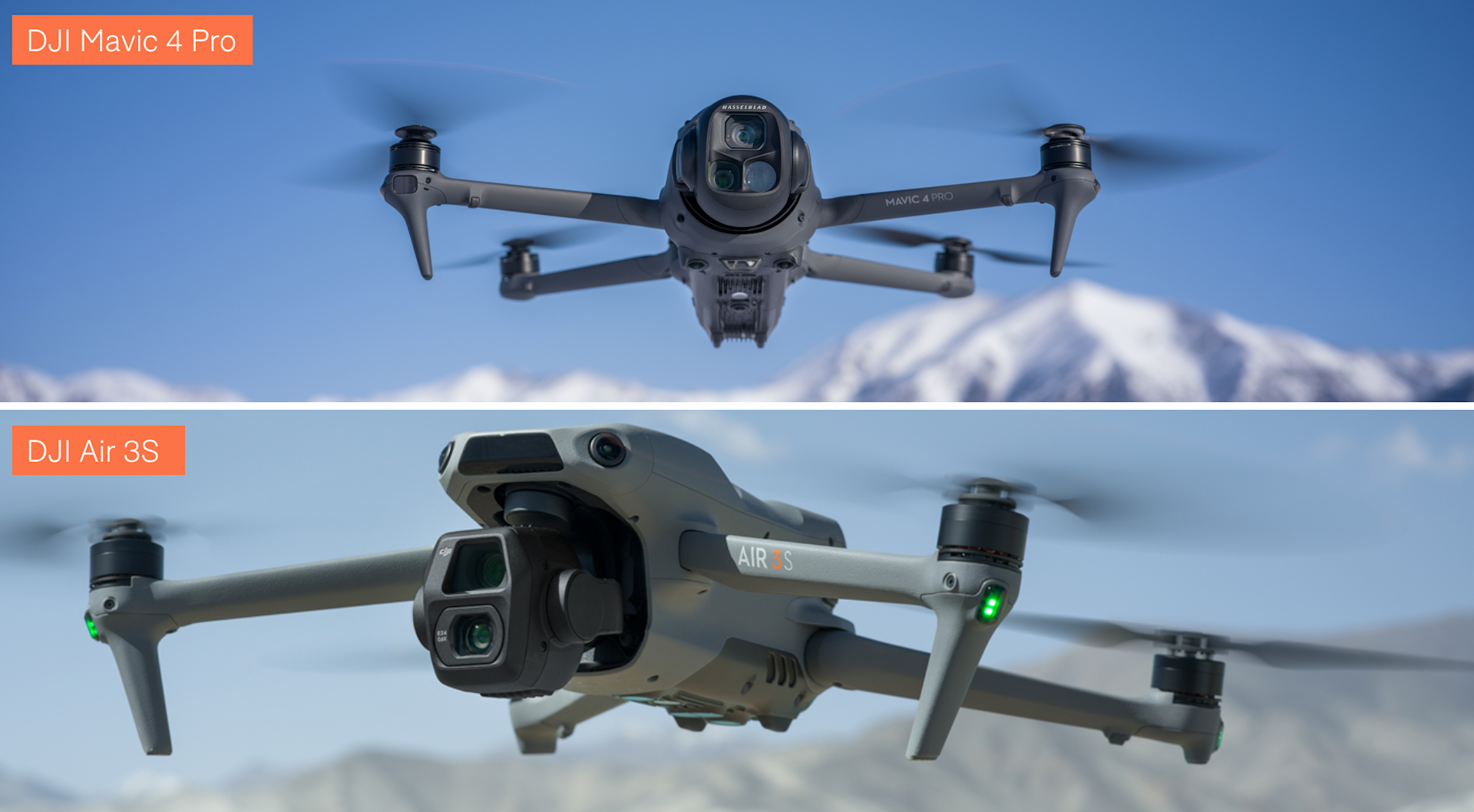
While both drones get the job done - and do so very well, the Mavic 4 Pro has some more sophisticated capabilities, and the Air 3S remains a smart choice for users seeking high-quality results in a more portable frame.
In this blog, we compare the two models across key areas to help you decide which drone best suits your requirements.
Key specs at a glance
Let's take a quick look at how the two camera drones measure up against one another.
Feature | DJI Mavic 4 Pro | DJI Air 3S |
|---|---|---|
Weight | 1063 g (36.9 oz) | 724 g (25.5 oz) |
Dimensions Folded | 257.6 × 124.8 × 106.6 mm (with propellers) 257.6 × 124.8 × 103.4 mm (without propellers) | 214.19 × 100.63 × 89.17 mm |
Dimensions Unfolded | 328.7 × 390.5 × 135.2 mm (without propellers) | 266.11 × 325.47 × 106.00 mm |
Image Sensor | Hasselblad: 4/3 CMOS, 100 MP Medium Tele: 1/1.3" CMOS, 48 MP Tele: 1/1.5" CMOS, 50 MP | Wide-Angle: 1" CMOS, 50 MP Medium Tele: 1/1.3" CMOS, 48 MP |
Max Video Resolution | Hasselblad: 6K/60fps HDR or 4K/120fps Medium Tele: 4K/60fps HDR or 4K/120fps Tele: 4K/60fps HDR or 4K/100fps | 4K/60fps HDR or 4K/120fps |
Gimbal | Infinity Gimbal with 360° rotation 70° upward shooting 2.7K/60fps cropped vertical shooting | 60° upward shooting supported |
Focusing & Tracking | Subject Focusing FocusTrack: ActiveTrack 360°, Spotlight, Point of Interest | Subject Focusing FocusTrack: ActiveTrack 360°, Spotlight, Point of Interest |
Obstacle Sensing | 0.1 lux Nightscape omnidirectional (Up/Down/Left/Right/Forward/Backward) Equipped with forward-facing LiDAR | Nightscape omnidirectional (Up/Down/Left/Right/Forward/Backward) Equipped with forward-facing LiDAR |
Max Flight Time | 51 mins | 45 mins |
Max Transmission Distance | 30 km (FCC) 15 km (CE/SRRC/MIC) | 20 km (FCC) 10 km (CE/SRRC/MIC) |
Camera systems
Both drones feature impressive camera systems, but which one truly delivers the better performance?
Feature | DJI Mavic 4 Pro | DJI Air 3S |
|---|---|---|
Image Sensors | Hasselblad: 4/3 CMOS, 100 MP Medium Tele: 1/1.3", 48 MP Tele: 1/1.5", 50 MP | Wide-Angle: 1", 50 MP Medium Tele: 1/1.3", 48 MP |
Lens – FOV / Format / Aperture / Focus | Hasselblad: 72°, 28 mm, f/2.0–f/11, 2 m to ∞ Medium Tele: 35°, 70 mm, f/2.8, 3 m to ∞ Tele: 15°, 168 mm, f/2.8, 3 m to ∞ | Wide: 84°, 24 mm, f/1.8, 0.5 m to ∞ Medium Tele: 35°, 70 mm, f/2.8, 3 m to ∞ |
ISO Range (Video) | Hasselblad: 100–12800 (Normal), 400–6400 (D-Log), 100–6400 (D-Log M/HLG) Medium/Tele: 100–12800 (Normal), 400–3200 (D-Log), 100–3200 (D-Log M/HLG) | 100–12800 (Normal) 100–3200 (D-Log M / HLG) Slow Motion: 100–6400 (Normal), 100–3200 (D-Log M / HLG) |
ISO Range (Photo) | 100–6400 (25 MP) 100–3200 (100 MP) 100–6400 (12 MP), 100–3200 (48/50 MP) | 100–6400 (12 MP) 100–3200 (48/50 MP) |
Shutter Speed | 1/16000–16 s (25 MP) 1/8000–8 s (100 MP)1/16000–2 s (Medium/Tele high-res) | 1/8000–2 s (Wide 50 MP) 1/16000–2 s (Medium Tele) 2.5–8 s simulated long exposure (12 MP modes) |
Max Image Size | Hasselblad: 12288×8192 Medium Tele: 8064×6048 Tele: 8192×6144 | Wide: 8192×6144 Medium Tele: 8064×6048 |
Still Photo Modes | Single Shot: 25/100 MPAEB, Burst, Timed (varied resolutions and intervals) | Single Shot: 12/50 MPAEB, Burst, Timed across both sensors |
Photo Format | JPEG, DNG (RAW) | JPEG, DNG (RAW) |
Video Resolution | Hasselblad: 6K@60fps, 4K@120fps, FHD@60fps, 4K Vertical Medium Tele: 4K@120fps, 2.7K Vertical@60fps Tele: 4K@100fps, 2.7K Vertical@60fps | 4K: 24–120fps FHD: up to 240fps2.7K Vertical: up to 60fps |
Video Format | MP4 (H.264 ALL-I / H.264 / H.265) | MP4 (H.264 / H.265) |
Max Video Bitrate | H.264: 90 Mbps H.265: 180 Mbps ALL-I: 1200 Mbps | H.264/H.265: 130 Mbps |
Colour Profiles & Sampling | 10-bit 4:2:2 (ALL-I)*, 10-bit 4:2:0 (H.265), 8-bit 4:2:0 (H.264) Supports Normal, HLG, D-Log M, D-Log *Only Mavic 4 Pro 512GB (Creator Combo) supports H.264 ALL-I recording. | Normal: 8-bit (H.264), 10-bit (H.265) HLG/D-Log M: 10-bit (H.264/H.265) |
Digital Zoom | Hasselblad: 1x–2.5x Medium Tele: 2.5x–6xTele: 6x–24x | Wide: 1x–2.9x Medium Tele: 3x–9x |
Supported File System | exFAT | exFAT |
Mavic 4 Pro leads with a triple-camera system, including a 100MP 4/3 Hasselblad sensor, a 48MP medium tele camera, and a 50MP tele camera.
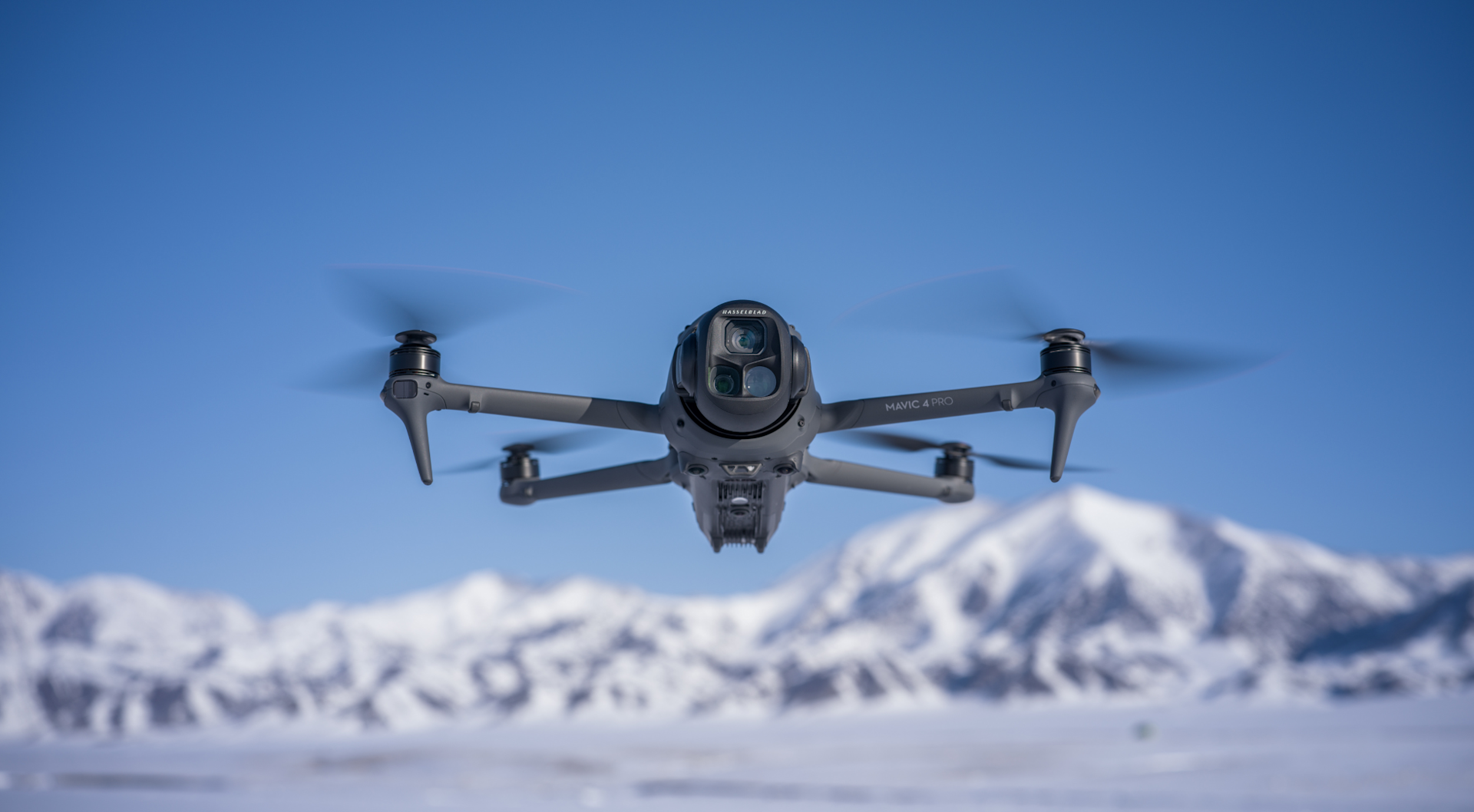
All three cameras support high-quality video capture, including 6K/60fps and 4K/120fps, along with advanced colour profiles like 10-bit D-Log M and HLG. You also get RAW stacking, Subject Focusing, and Free Panoramas for added creative control.
In comparison, the Air 3S has a dual-camera system: a 50MP 1-inch wide-angle camera and a 48MP 1/1.3" medium tele camera.
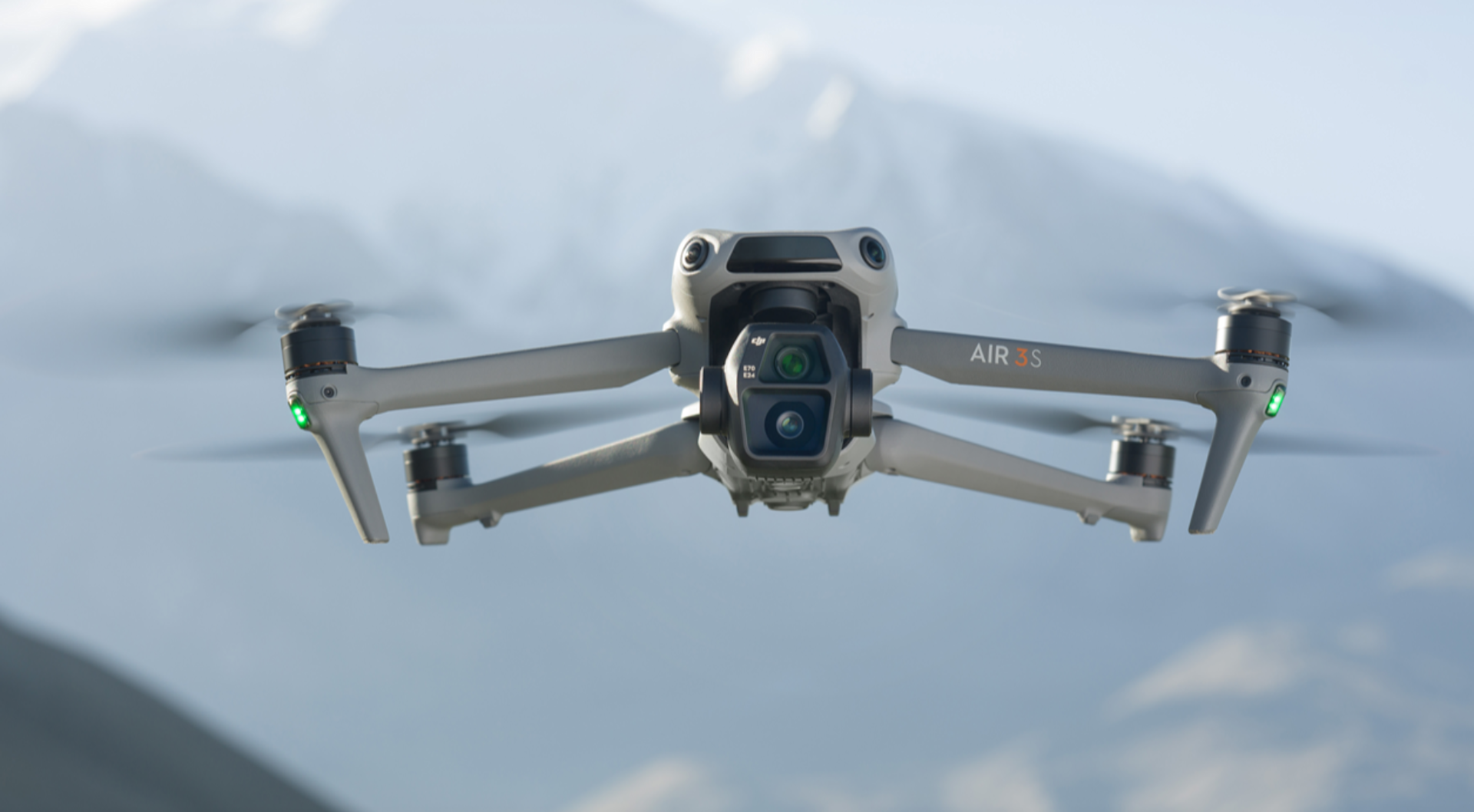
Both cameras support 4K/60fps HDR, slow motion up to 4K/120fps, and 14-stop dynamic range. The Air 3S delivers excellent results for travel and content creation, but the Mavic 4 Pro offers higher resolution, better colour depth, and more flexibility for professional post-production.
Flight performance
Each drone has a hefty flight time and impressive speed - let's look a little deeper at how these two operate in the air.
Feature | DJI Mavic 4 Pro | DJI Air 3S |
|---|---|---|
Takeoff Weight | Approx. 1063 g | 724 g |
Dimensions (Unfolded) | 328.7 × 390.5 × 135.2 mm (without propellers) | 266.11 × 325.47 × 106.00 mm |
Max Ascent Speed | 10 m/s (Sport Mode)6 m/s (Normal/Cine Mode) | 10 m/s |
Max Descent Speed | 10 m/s (Sport Mode)6 m/s (Normal/Cine Mode) | 10 m/s |
Max Horizontal Speed | 25 m/s (Sport)27 m/s with 2 m/s tailwind15 m/s (tracking) | 21 m/s (no wind)27 m/s with 6 m/s tailwind |
Max Takeoff Altitude | 6000 m (3000 m with prop guards) | 6000 m |
Max Flight Time | 51 minutes | 45 minutes |
Max Hovering Time | 45 minutes | 41 minutes |
Max Flight Distance | 41 km | 32 km |
Max Wind Speed Resistance | 12 m/s | 12 m/s |
Max Pitch Angle | 35° | 36° |
Operating Temperature | -10°C to 40°C | -10°C to 40°C |
GNSS Support | GPS + Galileo + BeiDou | GPS + Galileo + BeiDou |
Hovering Accuracy | Vertical: ±0.1 m (vision), ±0.5 m (satellite)Horizontal: ±0.3 m (vision), ±0.5 m (satellite) | Vertical: ±0.1 m (vision), ±0.5 m (satellite)Horizontal: ±0.3 m (vision), ±1.5 m (satellite) |
Internal Storage | 64 GB / 512 GB (approx. 42–460 GB usable) | 42 GB |
EU Drone Class | C2 | Not specified |
The Mavic 4 Pro offers up to 51 minutes of flight time, a top speed of 90kph, and a flight range of 41km. It uses DJI’s latest O4+ transmission system, supporting 30km range with 10-bit HDR video transmission.
The Air 3S follows closely with 45 minutes of flight time and a 10km range via O4 video transmission. For most users, this is more than enough, but the Mavic 4 Pro stands out for extended missions and signal stability over longer distances.
Obstacle sensing and safety
The Mavic 4 Pro and Air 3S both feature LiDAR and offer closely matched safety systems, making them well-equipped for secure and stable flights.
Feature | DJI Mavic 4 Pro | DJI Air 3S |
|---|---|---|
Sensing Type | Omnidirectional binocular vision+ Forward-facing LiDAR+ Bottom infrared sensor | Omnidirectional binocular vision+ Forward-facing LiDAR+ Bottom infrared sensor |
Forward Sensing | 0.5–24 m (meas.) 0.5–200 m (detect)≤18 m/sFOV: 180° × 180° | 0.5–18 m (meas.) 0.5–200 m (detect)≤15 m/sFOV: 90° × 72° |
Backward Sensing | 0.5–22 m≤18 m/s FOV: 180° × 180° | 0.5–18 m≤14 m/s FOV: 90° × 72° |
Lateral Sensing | 0.5–21 m≤18 m/s FOV: 180° × 180° | 0.5–30 m≤14 m/s FOV: 90° × 72° |
Upward Sensing | 0.5–18 m≤6 m/s FOV: 90° × 90° | 0.5–18 m≤6 m/s FOV: FB 72°, LR 90° |
Downward Sensing | 0.5–17 m≤6 m/s FOV: 180° × 180° | 0.3–14 m≤6 m/s FOV: FB 106°, LR 90° |
Forward LiDAR (3D Infrared Sensor) | 0.5–25 m (night use, >10% reflectivity) FOV: 60° Up/Down, 60° Left/Right | 0.5–25 m (night use, >10% reflectivity) FOV: 60° Up/Down, 60° Left/Right |
Downward Infrared Sensor | 0.3–8 mFOV: 60° FB, 60° LR | 0.3–8 mFOV: 60° FB, 60° LR |
Operating Environment | Vision sensors: Surfaces with patterns, lux > 0.1IR: Diffuse reflectivity > 20% | Vision sensors: Surfaces with patterns, lux > 1IR: Diffuse reflectivity > 20% |
The Mavic 4 Pro features 0.1-lux Nightscape omnidirectional obstacle sensing and uses LiDAR for forward-facing precision, even in low-light environments.
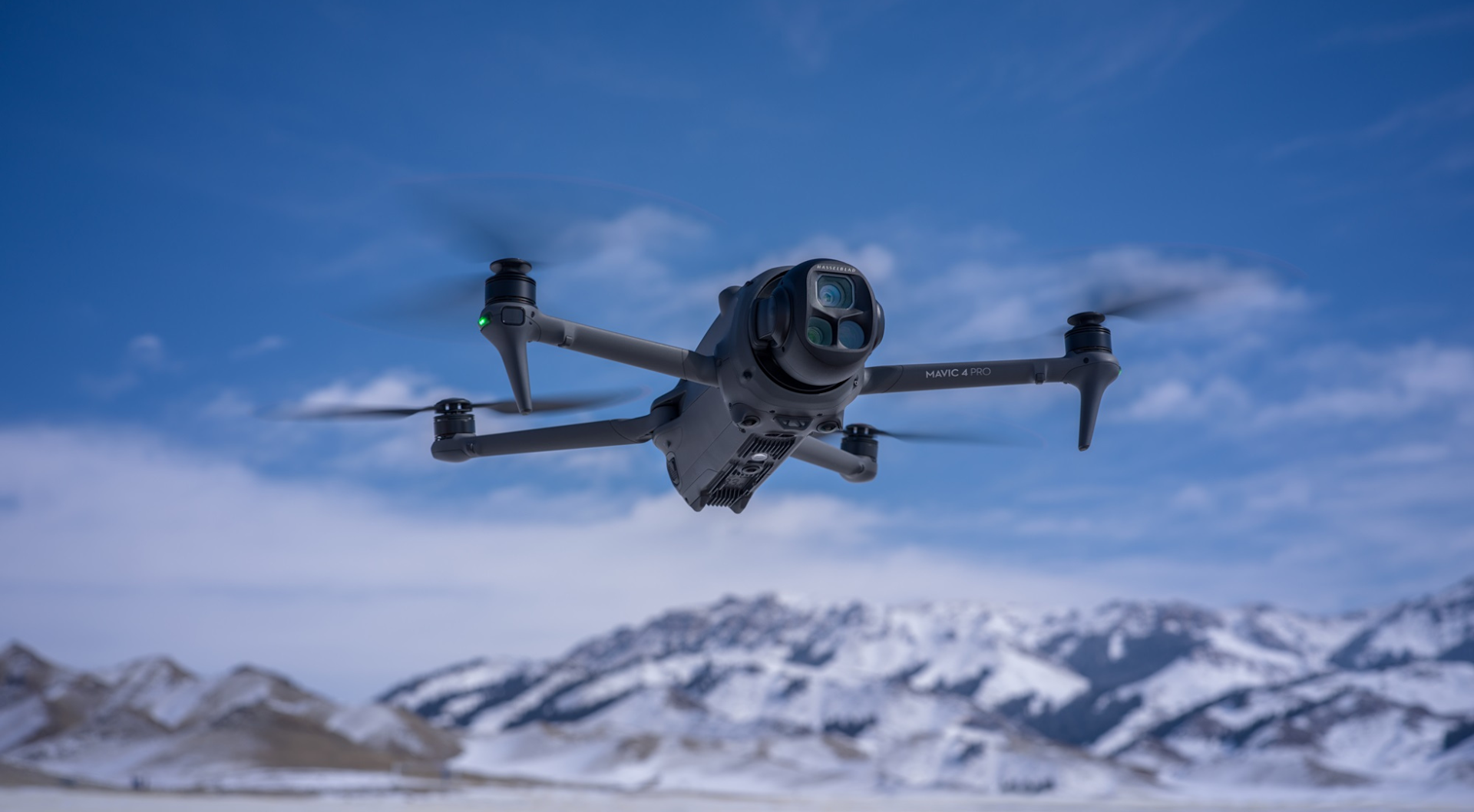
It can map surroundings in real time and use Smart RTH without GNSS. ActiveTrack 360° is also improved, supporting tracking in more complex scenarios and partial visibility.
The Air 3S also includes LiDAR, low-light sensing, and omnidirectional obstacle sensing, with ActiveTrack 360° and Subject Focusing.
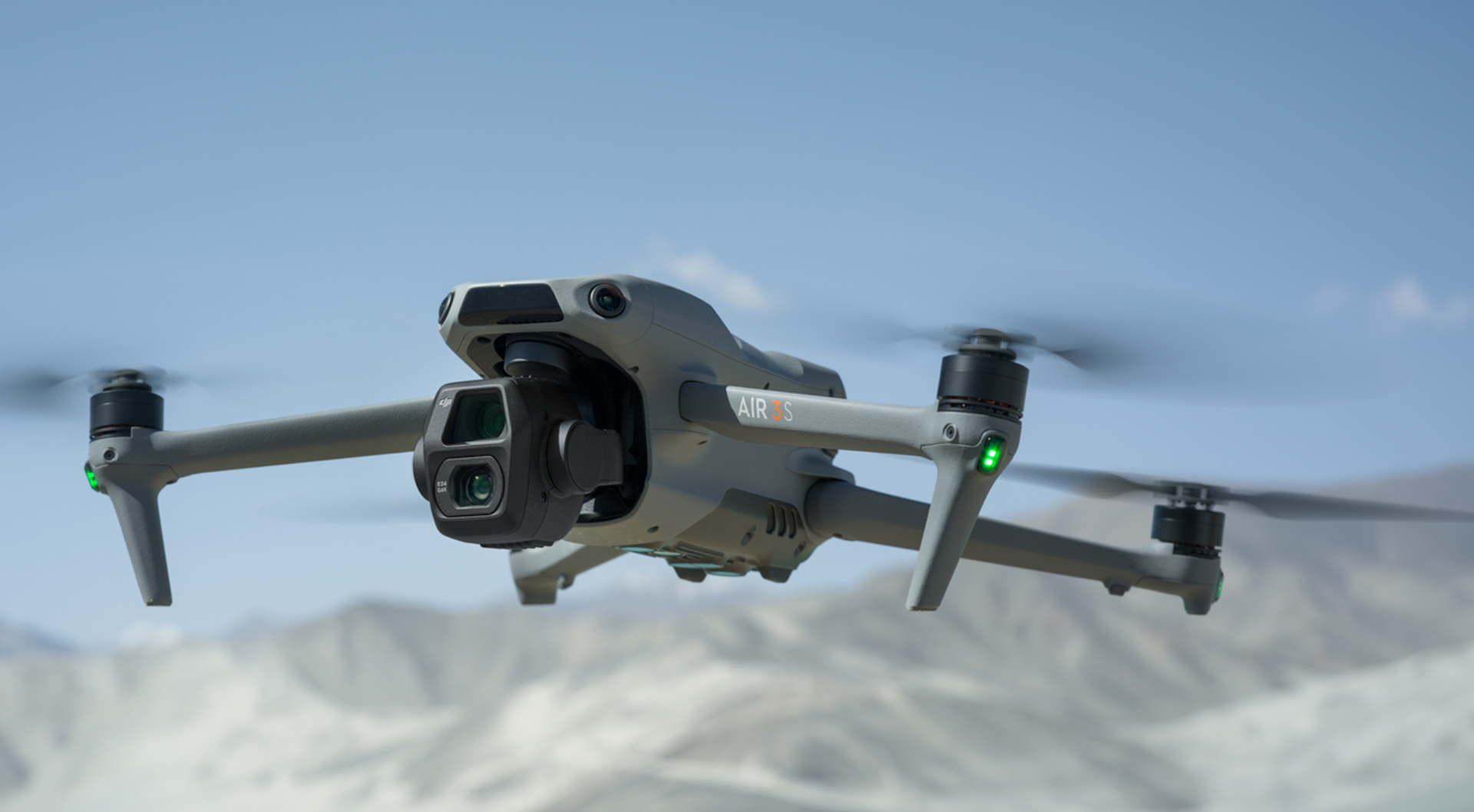
It can operate in darker environments than the original Air 3 and map surroundings without GNSS, offering excellent safety for its class.
Gimbal and creative tools
The Mavic 4 Pro raises the bar with its Infinity Gimbal, allowing operators to capture more creative and dynamic shots with ease.
Feature | DJI Mavic 4 Pro | DJI Air 3S |
|---|---|---|
Stabilisation | 3-axis mechanical gimbal (tilt, roll, pan) | 3-axis mechanical gimbal (tilt, roll, pan) |
Mechanical Range | Tilt: -164° to 160° Roll: -90° to 450° Pan: -22° to 22° | Tilt: -135° to 70° Roll: -50° to 50° Pan: -27° to 27° |
Controllable Range | Tilt: -90° to 70° Roll: -40° to 400° | Tilt: -90° to 60° Pan: -5° to 5° |
Max Control Speed | Tilt: 100°/sRoll: 100°/s | Tilt: 100°/s |
Angular Vibration Range | ±0.001° (hovering) ±0.003° (normal mode) ±0.005° (sport mode) | ±0.0037° |
The Infinity Gimbal on the Mavic 4 Pro offers 360° rotation and 70° upward shooting, enabling creative angles like Dutch tilts and more dramatic perspectives. It’s designed for professional-grade footage and allows for vertical shooting with the RC Pro 2.
The Air 3S includes creative modes like MasterShots, QuickShots, Hyperlapse, Waypoint Flight, and a new Free Panorama mode.
While its gimbal doesn’t offer the same freedom as the Mavic 4 Pro, it still delivers high-quality content with ease.
Storage and sharing
The Mavic 4 Pro has 64GB or 512GB onboard storage depending on the package*, with fast data transfer, parallel charging hub, and power bank mode.
The Air 3S has 42GB of internal storage and supports off-state QuickTransfers, making it easy to manage files on the go.
*The standard and Fly More Combo Mavic 4 Pros come with 64GB, upgrade to to the Creator Combo for 512GB.
Remote controllers
When it comes to controllers both drones are pretty equally matched.
The Mavic 4 Pro and Air 3S each supports both the DJI RC 2 and the new DJI RC Pro 2 (more on this RC later).
The RC 2 combines a compact design with a faster processor and DJI’s O4 video transmission, offering stable, low-latency performance at longer ranges.

DJI RC 2
The RC Pro 2 has launched with the Mavic 4 Pro (included in the Creator Combo), it sets a whole new level for RC performance features a 7-inch rotatable Mini-LED display, built-in microphone, vertical shooting sync, and an integrated flight simulator—making it ideal for professional users.
Additionally the Air 3S is compatible with the DJI RC-N3, so if you're after a simple RC with no frills, this will do the job.
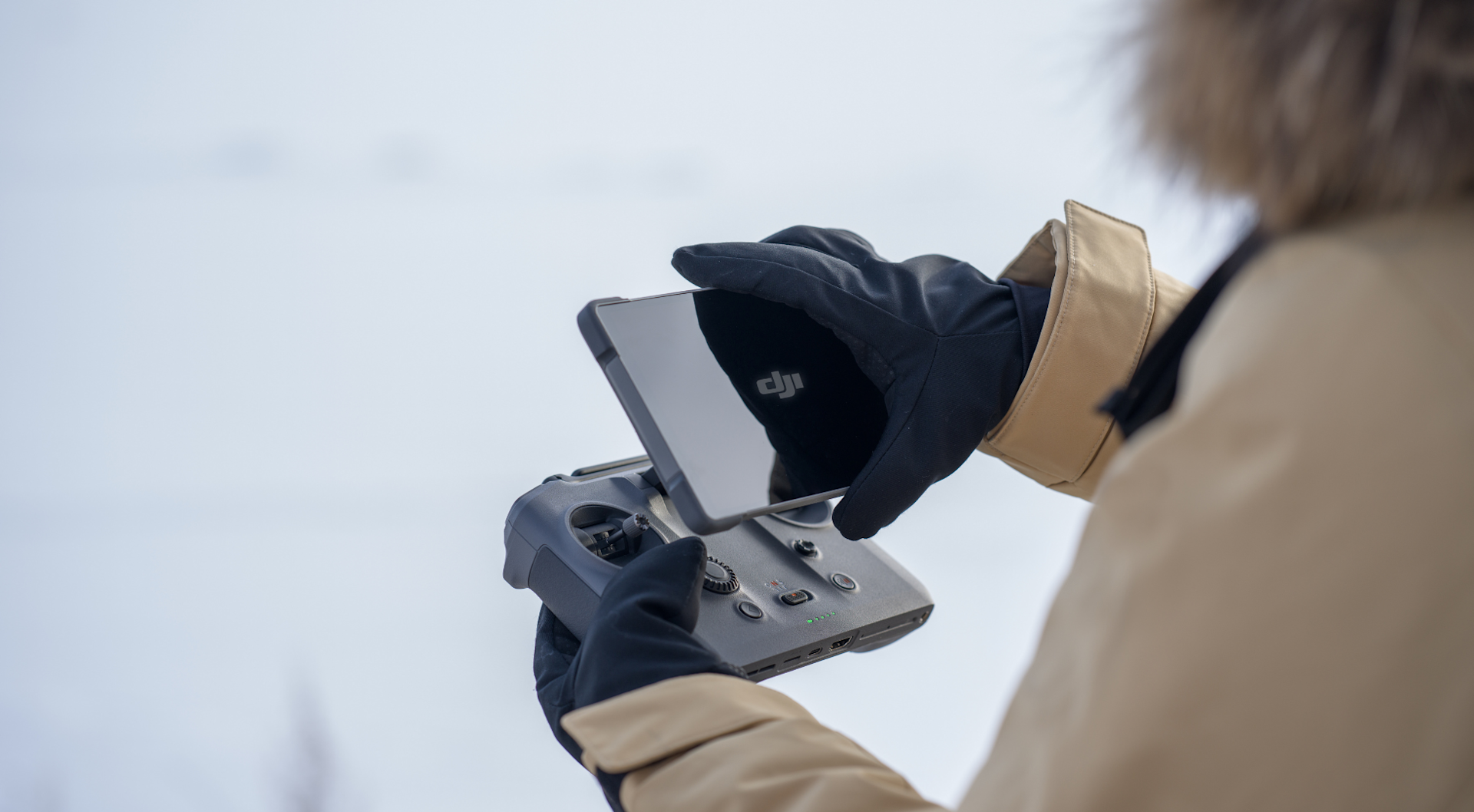
DJI RC Pro 2
Final thoughts
The DJI Mavic 4 Pro is built for professionals who need the best in image quality, creative flexibility, and flight performance. It’s ideal for filmmakers, inspectors, and commercial users working in demanding environments.
The DJI Air 3S is a strong all-rounder. It’s lighter, more affordable, and still packed with features that suit content creators, travellers, and anyone looking to step up their aerial photography.

If you’re serious about camera performance, long-range missions, or demanding projects, the Mavic 4 Pro is worth the investment. If portability and value are more important, the Air 3S is hard to beat.
Get in touch
Need help choosing, or you'd like to learn more? Contact the heliguy™ team for tailored advice or to order your drone today.
We're here to help for whatever your drone needs are, whether its flying fun or a business venture. And our DJI certified tech team is on hand to assist with repairs and maintenance advice.
